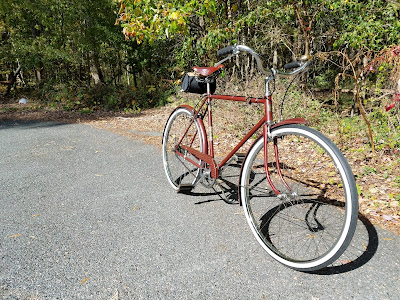I recently acquired a more premium set of wheels - a set of wheels from a 1947 Schwinn Continental 3-speed. The Continental had some upgrades over the standard wheelset: particularly stainless steel S6 rims and aluminum front hubs with oiler ports. Combined with double-butted spokes, the Continental 3-speed had a great set of wheels for that time period, or really any period of 3-speed bikes.
I bought these wheels specifically to upgrade the 1941 New World. As a rule of thumb, saving weight on a wheelset is one of the best places you can save weight on a bike. Weight off the wheels contributes substantially to the "feel" of the bike, as to quality wheel components. With that in mind, I tuned-up the Sturmey Archer AW hub; cleaned the wheelset; and trued them. I combined the wheels with the white wall Kenda tires (ISO 597), and put them on the New World.
The result is a tuned-up New World: a posh, sporty wheelset on a classic Schwinn fillet brazed bike. I rode the bike today, and despite adverse conditions and severe wind, it performed nicely and was quite a joy to ride.
The rear hub is a standard steel AW with a 10-47 (October 1947) date code. It's a little newer than the 1941 New World, but of the same general era of Schwinn 3-speeds. The hub required a tune-up: one replacement planet gear; one new pawl spring; and a new ball ring.
The days are getting shorter and colder, but today was still ride-able. The New World is a handsome, simple bicycle. If one characteristic about this one stands out, it's the well-balanced, sporty feel to the bike. It's surprisingly light and responsive for this era of bicycle construction, and everything just feels "right" on this bike. It's not my lightest, fastest, or more robust bike, but it is one of my most comfortable and pleasant to ride.
































